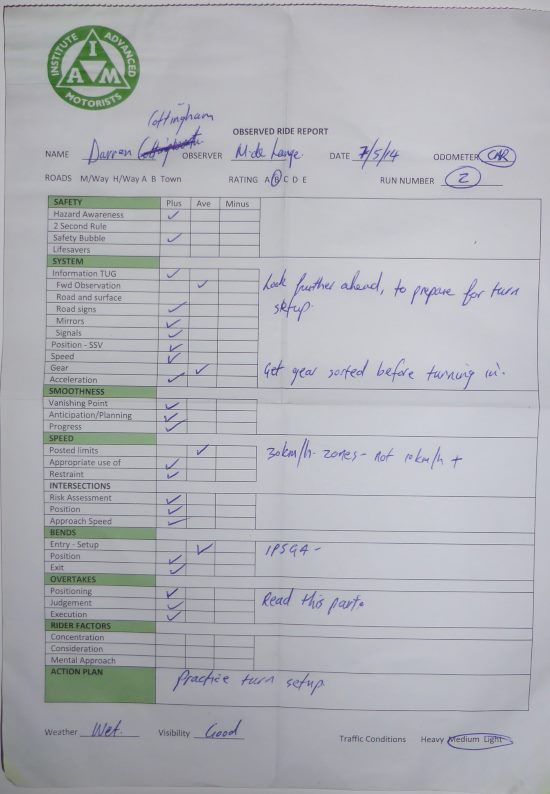If you want to take your driver education further you can talk to the Australian Institute of Advanced Motorists, based in Tasmania (address details are at the bottom of this article).
The IAM started life in the UK in 1956 when it took the police’s guidebook on driving and made it into a system of advanced driving that can be taught to non-enforcement drivers. It has over 100,000 members in the UK, and is active in several other countries, such as here and New Zealand.
I passed my IAM test in 2014 in New Zealand. I’ve had a licence for 23 years and wanted to see what extra knowledge was available and whether I could improve my driving, and now I can share some tips with you.
Practise based on the feedback
The IAM will assign you an observer who will go on an observation drive with you. They will be trained in the IAM methods and will be able to point out how you can improve your driving. At the end of each drive you will get a sheet showing how you did. It’s here where you will find out exactly how much you’ve forgotten of the advice your driving instructor told you when you were learning.

What we can see from my second run is that I needed to look further ahead to prepare for the turn setup, get into the right gear before turning, watch my speed in 30kph zones and pay attention to my overtaking (I was relying on the car’s full power rather than setting up the overtaking manoeuvre properly).
I went on a few practise runs to focus on the turning – mainly the problem was me trail braking into the corner and, because I had done a lot of motor racing, I was taking the ‘racing line’ through corners, which isn’t the right way.
Taking all that on board, I made sure that everywhere I went, I tried to remember what I’d been told. Which leads me to the second point…
Commentary
A commentary drive is where you describe the events that are unfolding on the road that could become a danger or will cause you to have to change your speed or road position. By saying what is happening you have to acknowledge everything on the road. When you first start trying to describe what’s happening, it is an overload for your brain, especially if you do it in the city – I would recommend starting in a small town or a rural area.
This video gives you an example:
Know your car’s gearbox, acceleration and braking
IAM observers will prefer that you change gears manually, even if you are in an automatic car, so you will need to know the shift up/down points for different speeds. If you just leave your car in D for drive then you don’t have as much control over the vehicle’s speed. Drivers of a manual car will know that you can change down a gear and use engine braking to help slow you down before intersections and corners, and this helps preserve the brakes, plus puts you in the right gear for acceleration when you need it.
Get used to listening to the engine tone as you are braking so that you know when to change down. This is harder in modern cars because they are so quiet. If you can’t hear the engine you will have to rely solely on the non-brake retardation of your car caused by the engine – you will feel how much engine braking you are getting and as this diminishes, you’ll know to change down another gear.
You will also have much more to think about than usual, therefore you will want to know the other functions in your car without thinking about them.
Scanning
Lazy driving is driving that only looks a few seconds ahead. The driver is being reactive to situations rather than proactively seeking out dangers. The first step in proactive driving is to make scanning part of your everyday driving. Scanning, which motorcyclists are usually well-schooled in, involves checking up the road as far as you can see, then to the left and right, and close, and behind in your mirrors. It constantly gives you a picture of where you are right now, and where you will be in the next 10-20 seconds.
As you can see in the video above, the driver is looking several sets of traffic lights ahead to anticipate his speed and braking, not just the traffic light immediately ahead. He’s constantly moving his eyes to take in the whole environment, not just focusing on the vehicle in front.
Think of it like pace notes in a rally car: pace notes are given by the co-driver a couple of corners ahead of where the driver is actually driving.
The IAM in the UK also produced these 10 tips for you, too (opens in a new window).
If you want to get hold of the IAM in Australia, here are the details:
73 Brent Street
Glenorchy TAS 7010
Contact
Tel: 03 6272 9610
